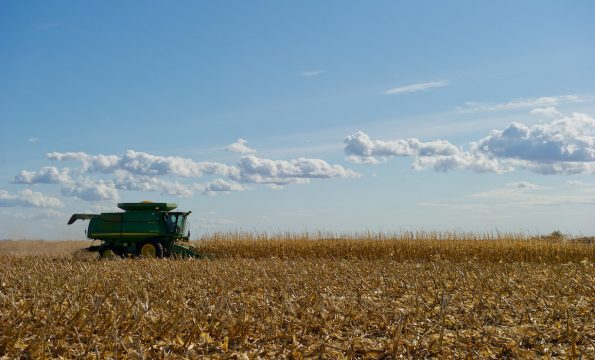Des Moines Register, by Donnelle Eller:
In less than an hour, the nearly 2,000 acres of corn and soybeans that Corey Hillebo and his family farm near Slater were flattened.
“Nothing in the path of the storm was unscathed,” said Hillebo, who lives near where Monday’s derecho, packing hurricane-force winds, left Heartland Cooperative’s massive grain storage bins twisted and crumpled.
“You drive around, there’s nothing that’s not leaning or flat,” he said.
Across Iowa, the storm hit about 10 million acres of crops, Gov. Kim Reynolds said Tuesday during a news conference. The Iowa Department of Agriculture said the storm affected roughly a third of the state, which grows about 32 million acres of corn, soybeans and other crops.
Reynolds said farmers have told her the damage “has just been devastating … they have never seen anything like this.”
The storm, with straight-line winds nearing 100 mph, pummeled homes, farms and businesses across dozens of counties in central Iowa. In addition to crops, it destroyed grain bins, machine sheds, barns and livestock buildings.
Justin Glisan, the state climatolo, said the storm lasted 14 hours and traveled 770 miles through the Midwest before losing strength in Ohio.
Joining Glisan on a call with reporters was Iowa Agriculture Secretary Mike Naig, who said elevators in the state have lost storage for “tens of millions of bushels” and that the capacity farmers lost amounts to millions of bushels more.
Workers will scramble to repair and rebuild grain bins. Still, elevators will most likely have to store more grain on the ground, and farmers will have to truck their harvest farther to store or sell it, adding costs and vulnerability.
Naig, who traveled Tuesday in central Iowa to assess the damage, said he was unable to put a dollar amount on the destruction, adding that some crops may recover over the next few days.
Some wind-damaged corn can continue to fill kernels and “will still make a crop. It will be able to stand up and produce,” Naig said. Other acres will be so damaged they cannot be harvested.
“Really, only time will tell,” Naig said.
He warned that farmers should stay in close contact with insurance agents and agronomists to help them through the disaster. “This is very emotional, a very emotional situation for a lot of Iowa farmers,” he said.
It’s been a tough few years for growers, who have struggled with trade wars, reduced exports and low prices. And demand for ethanol, which utilizes about half of Iowa’s nation-leading corn crop, has plummeted as Americans cut commuting and other travel to prevent the spread of the coronavirus.
Naig said that although growers in west-central Iowa have been experiencing a drought, the state’s harvest had looked promising, especially in east-central Iowa.
Hillebo said on Tuesday that flattened soybeans had begun to pop back up, but “I’m really worried about the corn.”
Some of it is “leaning over, some is crimped, and some has snapped off” at the root, he said. “Some of that we’ll be able to pick up in the combine. But if it’s snapped off, that’s really hard to get.”
Farmers also have to worry about the possibility that flattened corn plants will be susceptible to disease and will have to be harvested early.
“We were extremely dry, but I thought we had good potential for yield,” Hillebo said. “It feels like we’re getting kicked when we’re down. We weren’t looking at very good profitability. Then this happened.”
Near Toledo in eastern Iowa, Kevin Cooper said his family’s 100-year-old barn was leveled. “We can’t rebuild it,” said Cooper, an agriculture teacher in the Story County city of Nevada for 32 years. His brother’s machine shed was ripped off its foundation and blown into a nearby soybean field.
Hillebo, 32, who also raises pigs, hopes his family gets electricity back soon. But until power is restored, he has a generator to help cool, feed and water baby pigs that are coming this week.
“Everybody is safe. Everything else, we can fix or rebuild,” he said.
Prophetic Link:
“In accidents and calamities by sea and by land, in great conflagrations, in fierce tornadoes and terrific hailstorms, in tempests, floods, cyclones, tidal waves, and earthquakes, in every place and in a thousand forms, Satan is exercising his power. He sweeps away the ripening harvest, and famine and distress follow. He imparts to the air a deadly taint, and thousands perish by the pestilence. These visitations are to become more and more frequent and disastrous. Destruction will be upon both man and beast.” Great Controversy, page 589.






Comments